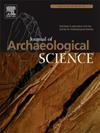Human femur and tibia retain primary lamellar bone formed during growth: measurement of anthropogenic radiocarbon in bone cross-sections
IF 2.5
1区 地球科学
Q1 ANTHROPOLOGY
引用次数: 0
Abstract
Bones exhibit isotope ratios with average seasonal variations resulting from constant remodeling; however, primary lamellar bone in some long bones represents tissue that forms during bone growth and persists without remodeling into adulthood. If this tissue grows sequentially, it could provide a novel source of information to reconstruct a personal history. This would also provide insight into the temporal changes in diet and migration of past human populations.
In this study, we measured anthropogenic radiocarbon (14C) in the femur of one individual and the tibia of the other who had been judicially dissected as unidentified bodies to determine the duration of primary lamellar bone formation. Samples were analyzed serially at 100–360 μm intervals over the direction of bone growth and 14C concentration decreased in the direction of bone growth. The endosteal areas of long bone cross-sections dominated by lamellar bone, containing sporadic osteons, were analyzed continuously during the growth period. The availability of time-series information on adolescent growth from the bone areas dominated by lamellar bone may be applied to life history reconstructions in anthropology. Importantly, long bones may retain information decades older than the time of death.
人类股骨和胫骨保留生长过程中形成的初级板层骨:骨横截面中人为放射性碳的测量
由于骨骼的不断重塑,其同位素比例呈现平均季节性变化;然而,一些长骨中的初级板层骨代表了在骨骼生长过程中形成的组织,并且在成年期没有重塑。如果这种组织是按顺序生长的,它将为重建个人历史提供一种新的信息来源。这也将为了解过去人类饮食和迁徙的时间变化提供洞见。在这项研究中,我们测量了一个人的股骨和另一个人的胫骨中的人为放射性碳(14C),这些人被司法解剖为身份不明的尸体,以确定初级板层骨形成的持续时间。样品沿骨生长方向以100-360 μm间隔连续分析,14C浓度沿骨生长方向降低。长骨横截面以板层骨为主,含散发性骨,在生长期间连续分析骨内区。从以板层骨为主的骨骼区域获得青少年生长的时间序列信息,可以应用于人类学的生活史重建。重要的是,长骨可能保留比死亡时间早几十年的信息。
本文章由计算机程序翻译,如有差异,请以英文原文为准。
求助全文
约1分钟内获得全文
求助全文
来源期刊

Journal of Archaeological Science
地学-地球科学综合
CiteScore
6.10
自引率
7.10%
发文量
112
审稿时长
49 days
期刊介绍:
The Journal of Archaeological Science is aimed at archaeologists and scientists with particular interests in advancing the development and application of scientific techniques and methodologies to all areas of archaeology. This established monthly journal publishes focus articles, original research papers and major review articles, of wide archaeological significance. The journal provides an international forum for archaeologists and scientists from widely different scientific backgrounds who share a common interest in developing and applying scientific methods to inform major debates through improving the quality and reliability of scientific information derived from archaeological research.
 求助内容:
求助内容: 应助结果提醒方式:
应助结果提醒方式:


